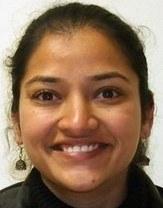Biography
Pallavi Singh is a John Henry Coates Research Fellow at Emmanuel College, University of Cambridge. Her research interests are focussed on improving photosynthesis in plants. Pallavi got a PhD from Jawaharlal Nehru University, India where she worked on the mechanisms underpinning flooding tolerance in rice. After finishing her PhD, she moved to Cornell University, USA, where she worked on rice-pathogen interactions. In 2017 she moved to Cambridge, UK as a postdoc at the Department of Plant Sciences and started her research on understanding the regulation of C4 photosynthesis. Pallavi is present on Twitter @Thepallavisingh
Research
50 years after the discovery of C4 photosynthesis, no transcription factors that regulate C4 photosynthesis genes have been defined. However, light is a strong cue to trigger the activation of photosynthesis machinery and so I wish to elucidate the gene regulatory networks at the onset of photosynthesis by light. The overarching hypothesis is that the incident light on an etiolated seedling activates the genes regulatory components of the photosynthetic apparatus. Thus, photomorphogenesis in the seedling is primarily mediated by the acquisition of DNA regulatory elements in cis that are recognized by trans-factors. As C4 photosynthesis has arisen over sixty times independently a strategic course of action would be to assess these regulatory components in both C3 and C4 plants. For this I make use of the C4 plant Gynandropsis gynandra which is the closest known C4 species to the lab rat of plant biology - C3 Arabidopsis thaliana. I am using an approach recently pioneered by the human genome project known as DNaseI-Seq, which provides information on regulatory footprints of DNA associated with transcription factor binding. Thus, DNaseI-Seq will be used to define cis-regulatory elements bound by transcription factors in closely related C3 and C4 plants. The outcomes will be major new insight into how photosynthesis is regulated in the ancestral C3 state, the derived and more C4 state, and also evolutionary inference about mechanisms that have driven the evolution of the efficient C4 phenotype.
My previous postdoctoral research experience focused on bacterial leaf-streak of rice, which is an economically important disease in many rice-growing regions of the world. My research was directed at understanding mechanisms of bacterial plant pathogenesis and plant defence to develop better means of disease control. The study aimed at the interaction of rice with its bacterial pathovar Xanthomonas oryzyae pv oryzicola (Xoc), in which transcription activator-like (TAL) effector proteins of the bacteria play an important role. Specifically, the work aimed at characterizing a sulphate transporter, OsSULTR3;6, a novel class of susceptibility gene in rice. A TAL effector, Tal2g, of Xoc, induces this gene. Preliminary results predicted that Tal2g could drive gene transcription by targeting both the forward and reverse strand of OsSULTR3;6 promoter. I tested this hypothesis by designing a dual reporter construct with firefly and renilla luciferase arranged head-to-head, and separated with a single-oriented test promoter.
Further, I performed Agrobacterium-mediated transient transformations in Nicotiana benthamiana plant, and established that Tal2g could direct bi-directional transcription in plants. Additionally, I steered a collaborative project on Rhizopus microsporus, a fungal rice pathogen, which causes rice seedling blight disease. Pathogenesis of the fungi on rice is exclusively attributed to presence of bacterial endosymbiont (Burkholderia rhizoxinica). Preliminary results hinted at the putative role of TAL effectors in establishing symbiosis and in turn contributing to pathogenicity in rice.
My doctoral research work focused on understanding rice tolerance to flooding, which for small farmers in the poorest areas of the world can wipe out the entire crop. Although 24% of the global rice crop is grown in paddies, most rice varieties will die if fully submerged. In India and Bangladesh alone, submergence destroys around four million tons of rice each year, enough to feed 30 million people. My research primarily focused on cell signalling, molecular biology, and biochemical aspects of Mitogen Activated Protein Kinase (MAPK) signalling components in rice. I presented molecular and physiological evidence for the key role of the MPK3-SUB1A1 module in acclimation of rice seedlings to submergence stress tolerance. The connection between MAPK signaling cascades and submergence tolerance was unknown. The ethylene response factor-like protein SUB1A was demonstrated to orchestrate a plethora of responses during submergence stress tolerance in rice. We reported that MPK3 is activated by submergence in a SUB1A-dependent manner. MPK3 was shown to physically interact and in turn, phosphorylate SUB1A1. Furthermore, SUB1A1 bound to the MPK3 promoter and regulated its own expression in a positive regulatory loop during submergence stress signalling. These results provided a mechanistic understanding of submergence tolerance in rice that is now being used to inform the deployment of this trait in breeding programmes.
Publications
Link to Pallavi's publications: https://scholar.google.co.uk/citations?user=fHgxlUgAAAAJ&hl=en


